Study offers new model for breast cancer
CAMBRIDGE, Mass. — The last few years have witnessed critical advances in breast cancer therapies. Still, the disease afflicts one in eight American women, and scientists have yet to develop a living model with which they can study the intricacies of human breast-tumor behavior.
Now, a team in the lab of scientist Robert Weinberg at Whitehead Institute for Biomedical Research has successfully grafted human breast tissue into the mammary glands of mice. As a result, the mice formed functional breasts that are capable of producing human breast milk. More importantly, some of these mice were engineered to form early stage breast tumors like those found in humans.
“This is the first experimental model of human breast cancer in the mouse that we’ve ever had,” says Charlotte Kuperwasser, lead author of the study and a former postdoctoral researcher in the Weinberg lab who now is an assistant professor at Tufts University School of Medicine. The study appears online this week in the early edition of the journal Proceedings of the National Academy of Sciences.
Currently, researchers studying human breast cancer tissue must rely on biopsies on slides for their work, an effective technique in many respects, but one that doesn’t allow scientists to view the tumors in action. Alternatively, they may propagate human breast cancer cells in culture. Attempts to create live models by injecting human cancer tissues beneath the skin of mice have been ineffective because the cancer cells used in these experiments typically are bred in Petri dishes and end up bearing little resemblance to human cancer. In addition, these tumor cells often stop growing after they’ve been injected.
“Here, the human tumor cells grow because we’ve created a human environment, and that’s a powerful tool” for breast cancer research, says Kuperwasser.
To create this environment, Kuperwasser separated the two primary types of human breast tissue: epithelial cells, which form the internal tree-like structure of the ducts that allow milk production to occur, and stromal cells, which are composed largely of fat cells, connective tissue cells and blood vessels. She removed all epithelial tissue from the mouse mammary gland and then “humanized” the remaining tissue by injecting a layer of specially engineered human stromal cells. This created a hospitable environment into which she could then incorporate human epithelial cells. The mice soon formed functional human mammary glands, and when these mice became pregnant, the engrafted cells produced human breast milk.
By genetically engineering the stromal cells with a virus that over-produces two proteins implicated in breast cancer, many of these mice formed pre-cancerous human growths in the breast tissue grafts.
“This means that we should now be able to use these mice to study the early stages of human breast cancer development,” says Weinberg, who also is a professor of biology at Massachusetts Institute of Technology.
These mice also may prove highly effective for testing potential breast cancer drugs. Because the tumors in the mice have developed naturally, results from such clinical trials most likely would provide a highly predictive indicator of how these drugs would behave in people. Kuperwasser is currently consulting with pharmaceutical companies who are developing breast cancer therapies. Meanwhile, Whitehead has filed a patent for this procedure.
The next step is to take advanced human breast cancer tissues from patients and incorporate them into these mice to see if the cancer continues to develop as it does in humans. “If so,” says Kuperwasser, “then we’ll really have a powerful model and tool to study both the development of cancer and how the tissue environment affects its behavior.”
This work was supported by the Jane Coffin Childs Memorial Fund Fellowship and by the National Institutes of Health/National Cancer Institute.
Citation
Kuperwasser, C., Chavarria, T., Wu, M., Magrane, G., Gray, J. W., Carey, L., ... & Weinberg, R. A. (2004). Reconstruction of functionally normal and malignant human breast tissues in mice. Proceedings of the National Academy of Sciences, 101(14), 4966-4971.
Topics
Contact
Communications and Public Affairs
Phone: 617-452-4630
Email: newsroom@wi.mit.edu


